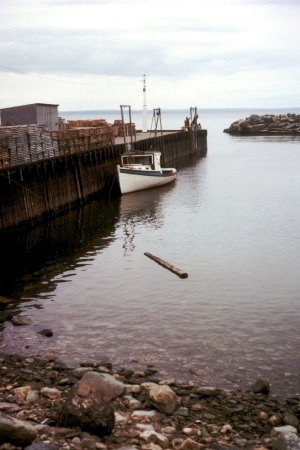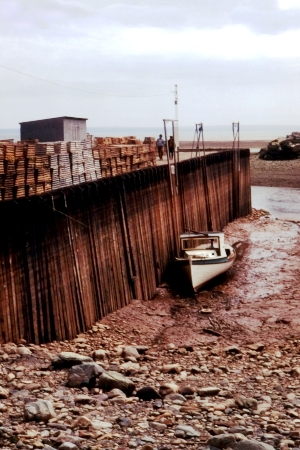7.6: Tides
( \newcommand{\kernel}{\mathrm{null}\,}\)
Tides
Wind is the primary force that causes ocean surface waves, but it does not cause the tides. Tides are the daily changes in the level of the ocean water at any given place. The main factors that causes tides are the gravitational pull of the Moon and the Sun (Figure 14.10).
 |
 |
| Figure 14.10: High tide (left) and low tide (right) at Bay of Fundy on the Gulf of Maine in North America. The Bay of Fundy has one of the greatest tidal ranges on Earth. | |

How does the Moon affect the oceans? Since the Moon is a relatively large object in space that is very close to the Earth, its gravity actually pulls Earth’s water towards it. Wherever the moon is, as it orbits the Earth, there is a high tide ‘bulge’ that stays lined up with the Moon. The side of the Earth that is furthest from the Moon also has a high tide ‘bulge’. This is because the Earth is closer to the moon than the water on its far side. The Moon’s gravity pulls more on the planet than the water on the opposite side. These two water bulges on opposite sides of the Earth aligned with the Moon are the high tides. Since ocean water is pulled higher in the areas of the two high tides, there is less water in between the two high tides. These areas are the low tides (Figure 14.11).
The tidal range is the difference between the ocean level at high tide and the ocean at low tide (Figure 14.12). Some places have a greater tidal range than others. High tides occur about twice a day, about every 12 hours and 24 minutes.


The Moon’s gravity is mostly responsible for our tides, but the Sun also plays a role (Figure 14.13). The Sun is much larger than our Moon. It has a mass about 27,500,000 times greater than the Moon. A very large object like the Sun would produce tremendous tides if it were as near to Earth as the Moon. However it is so far from the Earth that its effect on the tides is only about half as strong as the Moon’s. When both the Sun and Moon are aligned, the effect of each is added together, producing higher than normal tides called spring tides.
Spring tides are tides with the greatest tidal range. Despite their name, spring tides don’t just occur in the spring; they occur throughout the year whenever the Moon is in a new-moon or full-moon phase, or about every 14 days.
Neap tides are tides that have the smallest tidal range, and occur when the Earth, the Moon, and the Sun form a 90° angle. They occur exactly halfway between the spring tides, when the Moon is at first or last quarter. This happens because the Moon’s high tide occurs in the same place as the Sun’s low tide and the Moon’s low tide is added to by the Sun’s high tide.
The material that follows on tides was cut from Ocean Movements section under Coastal Processes
Tides are the daily rise and fall of sea level at any given place. The pull of the Moon’s gravity on Earth is the primarily cause of tides and the pull of the Sun’s gravity on Earth is the secondary cause (Figure below). The Moon has a greater effect because, although it is much smaller than the Sun, it is much closer. The Moon’s pull is about twice that of the Sun’s.
High tide (left) and low tide (right) at Bay of Fundy on the Gulf of Maine. The Bay of Fundy has the greatest tidal ranges on Earth at 38.4 feet.
Daily Tide Patterns
To understand the tides it is easiest to start with the effect of the Moon on Earth. As the Moon revolves around our planet, its gravity pulls Earth toward it. The lithosphere is unable to move much but the water is pulled by the gravity and a bulge is created. This bulge is the high tide beneath the Moon. The Moon’s gravity then pulls the Earth toward it, leaving the water on the opposite side of the planet behind. This creates a second high tide bulge on the opposite side of Earth from the Moon. These two water bulges on opposite sides of the Earth aligned with the Moon are thehigh tides.
Since so much water is pulled into the two high tides, low tides form between the two high tides (Figure below). As the Earth rotates beneath the Moon, a single spot will experience two high tides and two low tides every day.
The gravitational attraction of the Moon to ocean water creates the high and low tides.
A detailed animation of lunar tides is shown here: http://www.pbs.org/wgbh/nova/venice/tides.html.
The tidal range is the difference between the ocean level at high tide and the ocean at low tide (Figure below). The tidal range in a location depends on a number of factors, including the slope of the seafloor. Water appears to move a greater distance on a gentle slope than on a steep slope.
The tidal range is the difference between the ocean level at high tide and low tide.
Monthly Tide Patterns
If you look at the diagram of high and low tides in the Figure above, you’ll see that tides are waves. So when the Sun and Moon are aligned, what do you expect the tides to look like?
Waves are additive so when the gravitational pull of both bodies is in the same direction the high tides add and the low tides add (Figure below). Highs are higher and lows are lower than at other times through the month. These more extreme tides, with a greater tidal range, are called spring tides. Spring tides don’t just occur in the spring; they occur whenever the Moon is in a new-moon or full-moon phase, about every 14 days.
Spring tides occur when the tidal bulges from the Moon and Sun are aligned. The Moon is full in this image; in the bottom image the Moon would appear as a new Moon.
Here is a link to see these tides in motion: http://oceanservice.noaa.gov/education/kits/tides/media/tide06a_450.gif.
Neap tides are tides that have the smallest tidal range, and they occur when the Earth, the Moon, and the Sun form a 90o angle (Figure below). They occur exactly halfway between the spring tides, when the Moon is at first or last quarter. How do the tides add up to create neap tides? The Moon’s high tide occurs in the same place as the Sun’s low tide and the Moon’s low tide in the same place as the Sun’s high tide. At neap tides, the tidal range relatively small.
Neap tides occur when the Earth, the Sun, and the Moon form a right angle; the Moon is in its first or third quarter.
A simple animation of spring and neap tides is found here: http://oceanservice.noaa.gov/education/kits/tides/media/supp_tide06a.html.
High tides occur about twice a day, about every 12 hours and 25 minutes. The reason is that the Moon takes 24 hours and 50 minutes to rotate once around the Earth so the Moon is over the same location 24 hours and 50 minutes later. Since high tides occur twice a day, one arrives each 12 hours and 25 minutes. What is the time between a high tide and the next low tide?
This animation shows the effect of the Moon and Sun on the tides: http://www.onr.navy.mil/focus/ocean/motion/tides1.htm.
Some coastal areas do not follow this pattern at all. These coastal areas may have one high and one low tide per day or a different amount of time between two high tides. These differences are often because of local conditions, such as the shape of the coastline that the tide is entering.
- License: Public Domain: No Known Copyright


